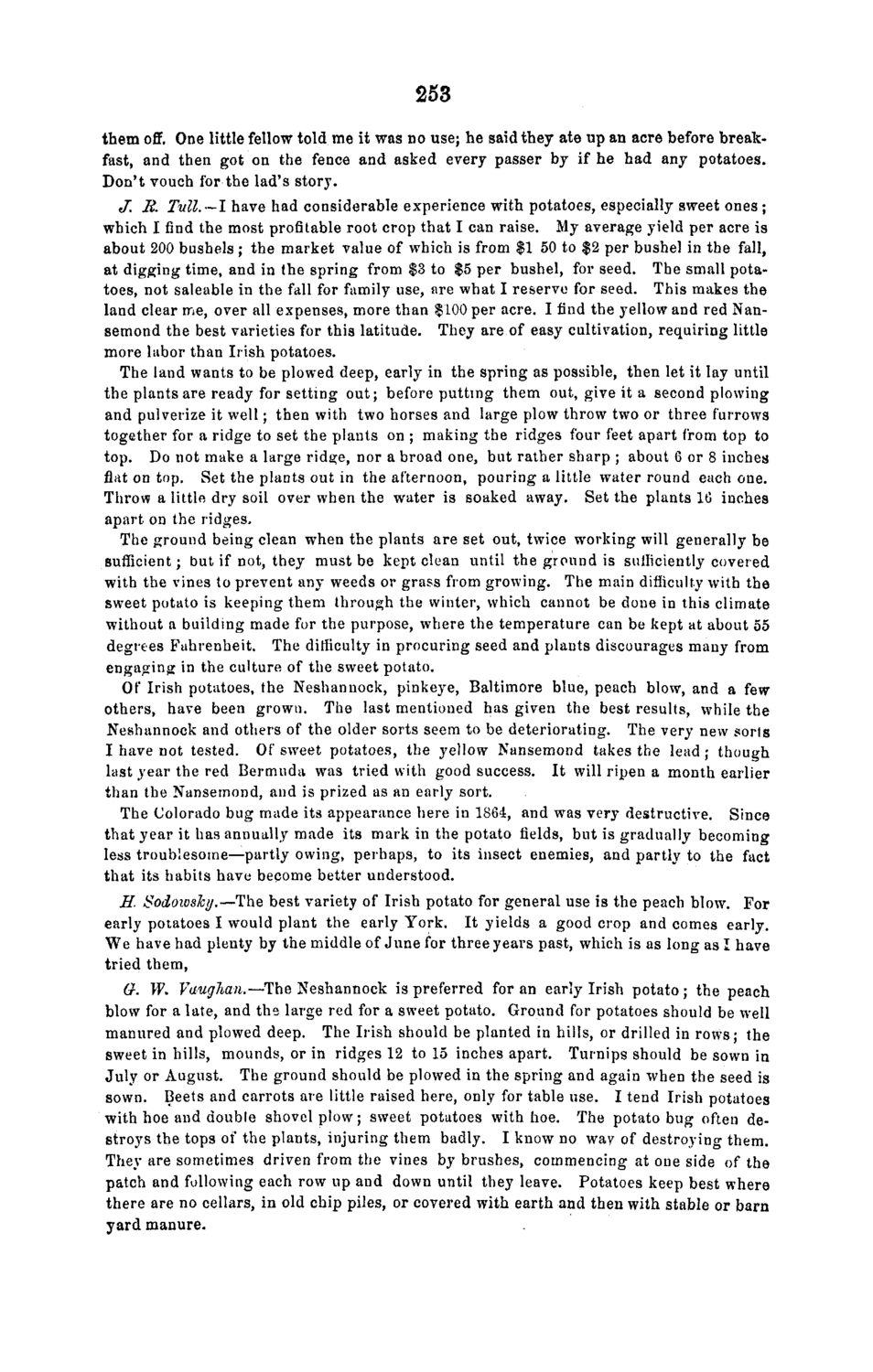| |
| |
Caption: Board of Trustees Minutes - 1868
This is a reduced-resolution page image for fast online browsing.

EXTRACTED TEXT FROM PAGE:
253 them off. One little fellow told me it was no use; he said they ate up an acre before breakfast, and then got on the fence and asked every passer by if he had any potatoes. Don't vouch for the lad's story. J. E. Tvll.—l have had considerable experience with potatoes, especially sweet o n e s ; which I find the most profitable root crop that I can raise. My average yield per acre is about 200 bushels; the market value of which is from $1 50 to $2 per bushel in the fall, at digging time, and in the spring from $3 to $5 per bushel, for seed. The small potatoes, not saleable in the fall for family use, are what I reserve for seed. This makes the land clear me, over all expenses, more than $100 per acre. I find the yellow and red Nansemond the best varieties for this latitude. They are of easy cultivation, requiring little more labor than Irish potatoes. The land wants to be plowed deep, early in the spring as possible, then let it lay until the plants are ready for setting out; before putting them out, give it a second plowing and pulverize it well; then with two horses and large plow throw two or three furrows together for a ridge to set the plants on ; making the ridges four feet apart from top to top. Do not make a large ridge, nor a broad one, but rather sharp ; about 6 or 8 inches flat on top. Set the plants out in the afternoon, pouring a little water round each one. Throw a little dry soil over when the water is soaked away. Set the plants 16 inches apart on the ridges. The ground being clean when the plants are set out, twice working will generally be sufficient; but if not, they must be kept clean until the ground is sufficiently covered with the vines to prevent any weeds or grass from growing. The main difficulty with the sweet potato is keeping them through the winter, which cannot be done in this climate without a building made for the purpose, where the temperature can be kept at about 55 degrees Fahrenheit. The difficulty in procuring seed and plants discourages many from engaging in the culture of the sweet potato. Of Irish potatoes, the Neshannock, pinkeye, Baltimore blue, peach blow, and a few others, have been grown. The last mentioned has given the best results, while the Neshannock and others of the older sorts seem to be deteriorating. The very new sorts I have not tested. Of sweet potatoes, the yellow Nansemond takes the l e a d ; though last year the red Bermuda was tried with good success. It will ripen a month earlier than the Nansemond, and is prized as an early sort. The Colorado bug made its appearance here in 1864, and was very destructive. Since that year it has annually made its mark in the potato fields, but is gradually becoming less troublesome—partly owing, perhaps, to its insect enemies, and partly to the fact that its habits have become better understood. H. Sodoioshy.—The best variety of Irish potato for general use is the peach blow. For early potatoes I would plant the early York. It yields a good crop and comes early. We have had plenty by the middle of J u n e for three years past, which is as long as I have tried them, G. W* VaugJian.—The Neshannock is preferred for an early Irish p o t a t o ; the peach blow for a late, and the large red for a sweet potato. Ground for potatoes should be well manured and plowed deep. The Irish should be planted in hills, or drilled in rows; the sweet in hills, mounds, or in ridges 12 to 15 inches apart. Turnips should be sown in July or August. The ground should be plowed in the spring and again when the seed is sown. Beets and carrots are little raised here, only for table use. I tend Irish potatoes with hoe and double shovel plow; sweet potatoes with hoe. The potato bug often destroys the tops of the plants, injuring them badly. I know no way of destroying them. They are sometimes driven from the vines by brushes, commencing at one side of the patch and following each row up and down until they leave. Potatoes keep best where there are no cellars, in old chip piles, or covered with earth and then with stable or barn yard manure.
| |